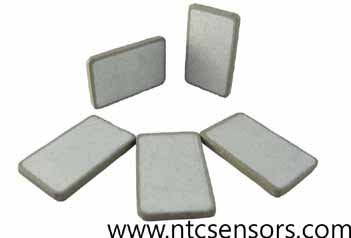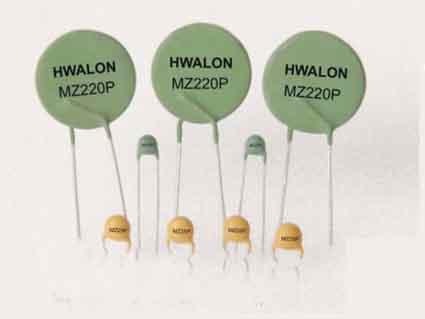Comparison of performance between ceramic PTC and organic PTC
Positive temperature coefficient thermistor (PTC) element as a new overcurrent protection. In recent years, it has been widely used in the user interface circuit of the program-controlled switch to prevent high-voltage lightning strikes and AC laps.
Thermistors (PTC) can be divided into organic polymer PTC and ceramic PTC according to the manufacturing materials. The organic PTC is formed by incorporation of a high molecular polymer into a carbon powder.
The carbon powder forms a carbon chain conductive, and the polymer expands when heated, and the carbon chain breaks to form a high resistance.
The ceramic PTC is formed by high temperature sintering of barium titanate powder with positive temperature coefficient characteristics by electronic ceramic process.
The main advantages of organic PTC are: The zero-power resistance at room temperature can be made smaller, suitable for series connection in overcurrent protection of power circuits with large current, and used for temperature fuses. The resistance value is fast, the heat capacity is small, and the recovery time is short.
But its biggest drawback is: It is determined by the material and structure of the organic polymer. After each impact through the flow, the resistance becomes large and cannot be restored to the original value, and when the high-voltage and high-curre

The main advantage of ceramic PTC is that it is easy to manufacture and relatively inexpensive. The non-operating current can be small, and the operating characteristics are best in the range of tens to thousands of Ω, which is suitable for small current overcurrent protection. And after multiple current surges, the resistance value does not change much, the recoverability and long-term stability are good, and the tolerance to pulse high current impact is also good. The disadvantage is that the negative resistance effect is easy to occur when the temperature is too high. For the user interface circuit of the program-controlled switch, anti-high voltage lightning strike and AC power connection. Since the loop current flowing during normal operation is small (about ten to several tens of mA), and the resistance of the series is allowed to be in the range of several Ω to several hundred Ω, both the organic PTC and the ceramic PTC are applicable. In particular, it is more suitable to use a ceramic PTC when the series resistance is allowed to be 10 Ω or more.

In the past, people have a common view and belief that:
The organic PTC has a faster response speed and a shorter operating time than the ceramic PTC. However, in recent years, the performance comparison test and practical effect of various specifications of organic PTC and ceramic PTC show that the situation is not entirely the same.
There is a conceptual misunderstanding here that needs to be clarified:
As far as the operation time of the PTC is concerned, it should be divided into two stages: the initial over-current preheating, the temperature accumulation time T1, and the temperature exceeding the Curie point after the Curie point. For an organic PTC, the time T2 required for the resistance to change from a few Ω to a few MΩ is indeed small, on the order of ms, while the T2 of a ceramic PTC is relatively long, on the order of tens of ms. However, for the preheating time T1 from the normal temperature to the Curie point temperature, the T1 of the ceramic PTC can be made small. For the total operating time T=T1+T2, the total operating time T of the ceramic PTC tends to be superior to the organic PTC when the inrush current flowing through the PTC is small. Ceramic PTCs have better current protection than organic PTCs.
According to the above analysis, the response speed of the PTC depends on the actual use and requirements, and cannot be generalized. Ceramic PTC's operating characteristics, small current protection capability, pulse high current impact capability and other indicators are better than organic PTC. Considering that after the current impact of the organic PTC, the resistance value becomes large and cannot be restored. Over time, it is easy to affect the transmission index of the user interface circuit, such as the attenuation of the interface, and the ceramic PTC has no such disadvantage. In addition, in the fault of the alternating current in the user circuit, the general fault current is small and the action time is long, which is often more harmful, so the small current protection is more important. For comprehensive consideration, the choice of ceramic PTC should be more appropriate.
Practice has proved that the use of domestic ceramic PTC is widely promoted on the switch to replace the expensive organic PTC. Not only can it reduce production costs for enterprises, improve economic efficiency, but also promote the development of domestic ceramic PTC national industry, and social benefits are also very good.
Thermistors (PTC) can be divided into organic polymer PTC and ceramic PTC according to the manufacturing materials. The organic PTC is formed by incorporation of a high molecular polymer into a carbon powder.
The carbon powder forms a carbon chain conductive, and the polymer expands when heated, and the carbon chain breaks to form a high resistance.
The ceramic PTC is formed by high temperature sintering of barium titanate powder with positive temperature coefficient characteristics by electronic ceramic process.
The main advantages of organic PTC are: The zero-power resistance at room temperature can be made smaller, suitable for series connection in overcurrent protection of power circuits with large current, and used for temperature fuses. The resistance value is fast, the heat capacity is small, and the recovery time is short.
But its biggest drawback is: It is determined by the material and structure of the organic polymer. After each impact through the flow, the resistance becomes large and cannot be restored to the original value, and when the high-voltage and high-curre

The main advantage of ceramic PTC is that it is easy to manufacture and relatively inexpensive. The non-operating current can be small, and the operating characteristics are best in the range of tens to thousands of Ω, which is suitable for small current overcurrent protection. And after multiple current surges, the resistance value does not change much, the recoverability and long-term stability are good, and the tolerance to pulse high current impact is also good. The disadvantage is that the negative resistance effect is easy to occur when the temperature is too high. For the user interface circuit of the program-controlled switch, anti-high voltage lightning strike and AC power connection. Since the loop current flowing during normal operation is small (about ten to several tens of mA), and the resistance of the series is allowed to be in the range of several Ω to several hundred Ω, both the organic PTC and the ceramic PTC are applicable. In particular, it is more suitable to use a ceramic PTC when the series resistance is allowed to be 10 Ω or more.

In the past, people have a common view and belief that:
The organic PTC has a faster response speed and a shorter operating time than the ceramic PTC. However, in recent years, the performance comparison test and practical effect of various specifications of organic PTC and ceramic PTC show that the situation is not entirely the same.
There is a conceptual misunderstanding here that needs to be clarified:
As far as the operation time of the PTC is concerned, it should be divided into two stages: the initial over-current preheating, the temperature accumulation time T1, and the temperature exceeding the Curie point after the Curie point. For an organic PTC, the time T2 required for the resistance to change from a few Ω to a few MΩ is indeed small, on the order of ms, while the T2 of a ceramic PTC is relatively long, on the order of tens of ms. However, for the preheating time T1 from the normal temperature to the Curie point temperature, the T1 of the ceramic PTC can be made small. For the total operating time T=T1+T2, the total operating time T of the ceramic PTC tends to be superior to the organic PTC when the inrush current flowing through the PTC is small. Ceramic PTCs have better current protection than organic PTCs.
According to the above analysis, the response speed of the PTC depends on the actual use and requirements, and cannot be generalized. Ceramic PTC's operating characteristics, small current protection capability, pulse high current impact capability and other indicators are better than organic PTC. Considering that after the current impact of the organic PTC, the resistance value becomes large and cannot be restored. Over time, it is easy to affect the transmission index of the user interface circuit, such as the attenuation of the interface, and the ceramic PTC has no such disadvantage. In addition, in the fault of the alternating current in the user circuit, the general fault current is small and the action time is long, which is often more harmful, so the small current protection is more important. For comprehensive consideration, the choice of ceramic PTC should be more appropriate.
Practice has proved that the use of domestic ceramic PTC is widely promoted on the switch to replace the expensive organic PTC. Not only can it reduce production costs for enterprises, improve economic efficiency, but also promote the development of domestic ceramic PTC national industry, and social benefits are also very good.





